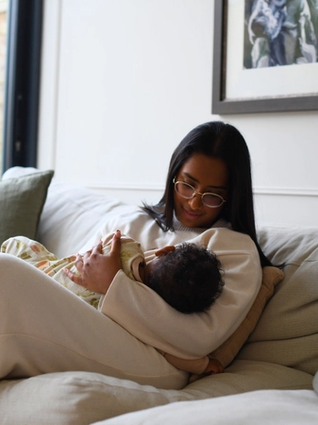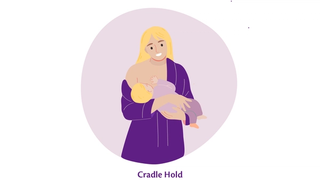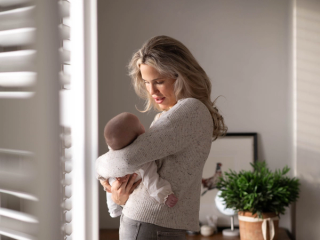
- Home
- Advice Hub
- Baby
- Baby Feeding
- Breastfeeding Positions
Breastfeeding Positions
Learn about the different breastfeeding positions to improve latch, comfort and feeding.
There are many different ways you can breastfeed your baby and it’s a good idea to try out different positions to work out which you prefer. There is not simply one right breastfeeding position, however some positions will be better than others depending on let down and latch quality, but this can vary depending on the size of your breasts.
Different nursing positions for breastfeeding can also work well in different situations, so there’s no need to stick to one, although many mums will have a tried-and-tested favourite they use more than others.
Always remember: breastfeeding is a skill to be learned, not an innate talent. It can take a little bit of practice to master a new position. Stick with it; you’ll get there.
Getting Ready to Breastfeed
Before you get into your breastfeeding position, make sure you find a comfortable space to sit. Gathering some pillows to use for support will take some of the strain off your back and other parts of your body.
A breastfeeding or nursing pillow can help make sure your baby is supported and at the right height to latch on. If you don’t have a product designed specifically for breastfeeding the same comfort can be created with ordinary pillows or cushions.
Having anything else you need nearby, such as a glass of water, muslin cloths or even a snack means you can relax and take the time you need to breastfeed your baby.

Cradle hold
This is a very popular breastfeeding position and is usually the first one a new parent tries with their baby. In a cradle hold, your baby lies on their side across your lap so they are facing you; you are tummy to tummy.
For the cradle hold, sit in a comfy chair with arm rests, or a bed with cushions or pillows around you. Lie your baby across your lap, facing you. Place your baby's head on your forearm – nose towards your nipple. Your hand should support the length of their body. Place your baby's lower arm under yours. Check to make sure your baby's ear, shoulder and hip are in a straight line.
The best part of the cradle hold is it is quite easy to get the hang of, making it a good one for first time mums. The position gives you a good view of your baby’s latch so you can carefully guide them onto the nipple.
This hold might be uncomfortable if you have just had a caesarean section as the position of your baby could irritate your scar while it is healing. If you're sitting on a chair, help prevent your back from aching by resting your feet on a stool as this will stop you from leaning forward which can make your back ache.

Lying back breastfeeding
This breastfeeding position encourages your baby to use their natural instincts and is sometimes referred to as biological nursing. You can use this position in bed, on the sofa or in a recliner but make sure your back, head, shoulders and arms are supported with pillows or cushions.
Lean back and place your baby tummy down on your chest so their cheek is near your breast. Laid back nursing is a great opportunity for skin-to-skin contact and works best if your breast is uncovered and easily available to your little one.
You can allow the baby to self latch in this position. Alternatively, you can try rubbing your nipple on your baby’s top lip to encourage them to open their mouth nice and wide. Then bring them in to help them latch on, making sure their chin touches your breast first.
Make sure your baby’s feet aren’t dangling but are supported by your body and use one of your hands to hold their bottom or thigh. You may want to use your other hand to hold your breast.
This relaxed position is great for the first few days and weeks after birth and can be really useful in helping to get breastfeeding established. Gravity will help support your baby and help them latch on properly, reducing the risk of you getting sore nipples.
It is also a great position if you are recovering from a c-section delivery when it might be uncomfortable to sit upright. If you have had a caesarean, make sure you keep your baby away from your healing wound – they can lie across you rather than down your body.

Rugby hold breastfeeding
This breastfeeding position is a good option after a caesarean section as it keeps the baby away from your stomach and scar. It is chosen by mums of twins to feed both babies at the same time.
Sit in an upright position with a cushion or pillow next to you on the side you want to feed from. Place your baby facing you with their hips near your own hips so their legs go under your arm and their nose is level with your nipple.
Use the palm of your hand to support the back of your baby’s head and gently guide them onto your nipple. Their back will lie along your arm.
One of the major benefits of this position is it leaves you with one hand free- unless you are feeding twins, or you want to support your breast. It is also a great hold for mums who have a strong and powerful let-down reflex as it is easier for babies to cope with the flow of milk in this position.
One thing to watch out for is that if your baby is fairly long, they may push their feet against the back of the chair, especially as they get bigger and stronger. You can get around this by making sure their legs are resting along the back of the chair with the soles of their feet pointing upwards.

Breastfeeding positions for twins
It is not unusual for twins to be born early or even premature, adding challenges to breastfeeding initially. If you find breastfeeding difficult with your twins, it does not mean you will not be able to feed them and always keep asking for support from a feeding professional. Twins can be fed together or separately, and you may find you swap and change between this for different situations or stages of development.
Rugby hold (as above) Parallel and Crossover holds are good positions to try with twins.
The Parallel hold position is where both babies are held in the same direction, side by side, with one baby in each arm.
The Crossover hold position is where one baby is cradled across your body while the other crosses over in the opposite direction, creating an "X" shape with their bodies.
What to do if you are experiencing challenges with breastfeeding?
It is not unusual to experience challenges in breastfeeding, if you are finding this new experience more difficult than expected it is important to reach out for help from a midwife, health visitor, public health nurse or a breastfeeding specialist. In most cases there is a solution and professionals are always here to help.
Remember, while breastfeeding is natural, it’s not always easy, and it may not happen right away. Learning to understand your baby’s feeding technique can take several weeks to master. Talking to those around you about how you are feeling can also be a good way to relieve the stress you are feeling around feeding. Staying hydrated and well-nourished will also help to keep your energy up and support milk production. Take feeding one day at a time, be kind to yourself!
FAQs around breastfeeding positions
It's best to avoid any breastfeeding position that causes discomfort. Instead, aim for a position that helps you feel supported and relaxed, as this will prevent tension in your back, neck, and shoulders. Your chosen position should also ensure your baby is correctly positioned for optimal attachment and feeding.
There isn’t a one-size-fits-all approach to breastfeeding positions during pregnancy. However, many pregnant women, especially those who are also breastfeeding, often experience fatigue and aching muscles. In such case, side-lying or laid-back positions can be very helpful, as they allow the mother to rest while feeding.
If you’re experiencing a fast letdown, laid-back positions can be effective. Try positioning your baby with their tummy against yours and their bottom lower than their head. Alternatively, you can express a little milk beforehand or gently unlatch your baby during the fast letdown, then relatch them once it has settled.












